
The Cathedral Church of St. Barnabas is a cathedral of the Roman Catholic Church in the city of Nottingham in Nottinghamshire, England. It is the mother church of the Diocese of Nottingham and seat of the Bishop of Nottingham. The cathedral is a grade-II* listed building.
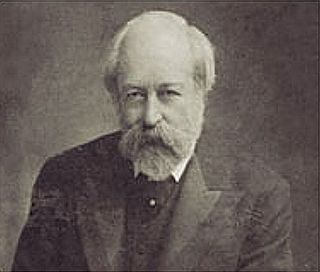
George Frederick Bodley was an English Gothic Revival architect. He was a pupil of Sir George Gilbert Scott, and worked in partnership with Thomas Garner for much of his career. He was one of the founders of Watts & Co.
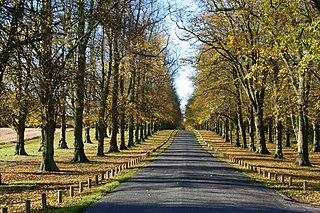
Clumber Park is a country park in The Dukeries near Worksop in the civil parish of Clumber and Hardwick, Nottinghamshire, England. The estate, which was the seat of the Pelham-Clintons, Dukes of Newcastle, was purchased by the National Trust in 1946. It is listed Grade I on the Register of Historic Parks and Gardens.

Southwell is a minster and market town, and a civil parish, in the district of Newark and Sherwood in Nottinghamshire, England. It is home to the grade-I listed Southwell Minster, the cathedral of the Anglican Diocese of Southwell and Nottingham. The population of the town was recorded at 7,491 in the 2021 census.
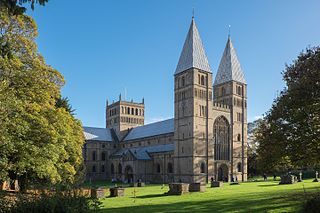
Southwell Minster, formally the Cathedral and Parish Church of the Blessed Virgin Mary, is a Church of England cathedral in Southwell, England. The cathedral is the seat of the bishop of Southwell and Nottingham and the mother church of the diocese of Southwell and Nottingham; it is governed by a dean and chapter. It is a grade I listed building.
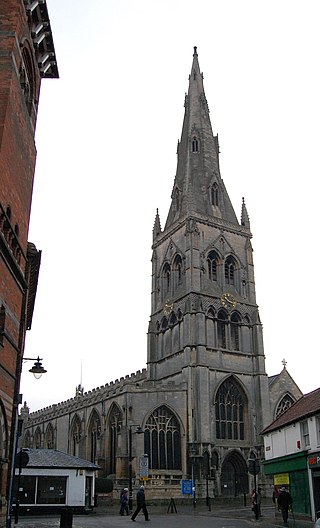
St Mary Magdalene Church, Newark-on-Trent is the parish church of Newark-on-Trent in Nottinghamshire, England. It is dedicated to Mary Magdalene and is the tallest structure in the town.

St George in the Meadows is a parish church in the Church of England in The Meadows, Nottingham, England.
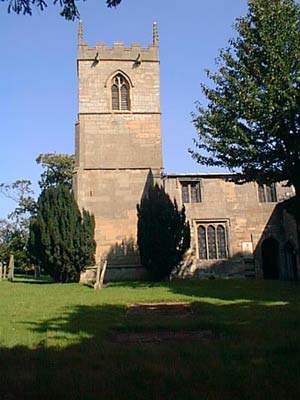
The Church of Our Lady of Egmanton is a Church of England parish church in Egmanton, Nottinghamshire, and the location of the Shrine of Our Lady of Egmanton.

St Helena's Church, West Leake is a parish church in the Church of England in West Leake, Nottinghamshire.
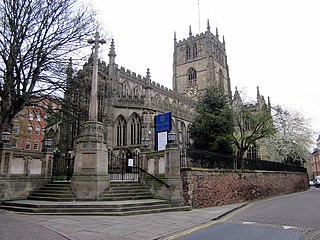
The Church of St Mary the Virgin is the oldest parish church of Nottingham, in Nottinghamshire, England. The church is Grade I listed by the Department for Digital, Culture, Media and Sport as a building of outstanding architectural or historic interest. It is one of only five Grade I listed buildings in the City of Nottingham.

The Church of St. James is a parish church in the village of Normanton on Soar, Nottinghamshire. The Church was designated as a Grade I listed building on 13 October 1966, for being "of exceptional interest".

All Saints' Church, Winthorpe is a Grade II listed parish church in the Church of England in Winthorpe, Nottinghamshire, England. The current building, the construction of which was completed in 1888, is at least the third version of the church, which dates back to at least the early 13th century. All Saints' Church was commissioned by the church rector, Edward Handley, in memory of one of his relatives.

St Mary's Church, Ilkeston is a Grade II* listed parish church in the Church of England in Ilkeston, Derbyshire. Built in the 14th century, it is known as the "Mollis Chapel" because of a stained glass window which shows the rising sun above the cross which was fixed to it by the local saint.

St Mary the Virgin's Church, Denby is a Grade I listed parish church in the Church of England in Denby, Derbyshire.

St Michael and All Angels’ Church, Church Broughton is the Church of England parish church of Church Broughton, Derbyshire. It is a Grade I listed building.

St Mary's Church, Rosliston is a Grade II* listed parish church in the Church of England in Rosliston, Derbyshire.

St Luke's Church, Shireoaks is a Grade II listed Church of England parish church in Shireoaks, Nottinghamshire.

St Stephen's Church, Borrowash is a parish church in the Church of England in Borrowash, Derbyshire.

St Barnabas' Church, Derby is a Church of England parish church in Derby, Derbyshire.

Clumber and Hardwick is a civil parish in the Bassetlaw district, in the county of Nottinghamshire, England. The parish includes the settlement of Hardwick Village and Clumber Park, a country park. In the UK census of 2021 the parish had a population of 66. The parish lies in the north west of the county, and south west within the district. It is 125 miles north west of London, 22 miles north of the city of Nottingham, and 3½ miles south east of the market town of Worksop.The parish touches Babworth, Carburton, Elkesley, Perlethorpe cum Budby and Welbeck. The parish was formed on 1 April 1994. The area is within Sherwood Forest and has close historical associations with the Dukes of Newcastle, being part of a wider region known as The Dukeries. There are 26 listed buildings in Clumber and Hardwick.





















